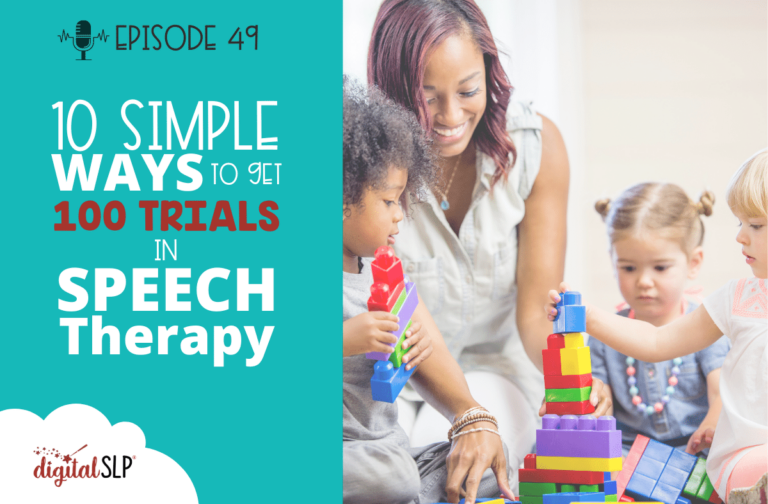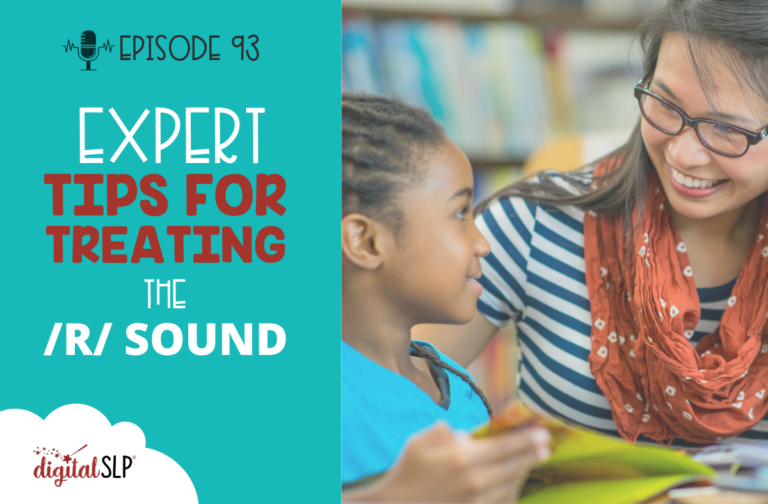It can be extra challenging to teach reading comprehension skills to our students. Why is this? Well, when we are teaching phonemic awareness and other micro skills, there are often specific rules that help guide us. However, teaching to comprehend as whole, is a bit more abstract of a concept. This, of course, makes it more difficult to teach. Below, I will very briefly outline some ideas, but you’ll want to make sure you listen to the podcast to get the details.
1) Identify and categorize information.
2) Run a book club.
3) Use writing to facilitate reading performance.
4) Use a collection of comprehension strategies, such as:
- Prediction.
- Imagery.
- Summarizing.
- Questioning.
I hope that enjoyed listening to today’s episode and that you found these tips to be helpful. I did just want to remind you to that the Digital SLP rates are going up on February 1st, so you have today and tomorrow to lock in your rate before it goes up!
Links & Resources:
- Digital SLP Membership
- Written Language Disorders: Treatment. (n.d.). Retrieved January 21, 2018, from http://www.asha.org/PRPSpecificTopic.aspx?folderid=8589942549§ion=Treatment
- Hebert, M. (2010). Writing to Read: Evidence for How Writing Can Improve Reading. A Report from Carnegie Corporation of New York. New York: Carnegie Corporation of New York.
- Reading Strategies. (n.d.). Retrieved January 21, 2018, from https://www.readinghorizons.com/reading-strategies/teaching/comprehension/building-reading-comprehension-through-questioning-techniques
Full Transcript of Podcast: Reading Comprehension Strategies for the SLP
Episode 27 - Reading Comprehension Strategies for the SLP
You're listening to the Speech Space Podcast, a podcast full of tips and resources for SLPs. I'm your host, Jessica Cassity, and this is Episode 27.
Today, we're going to be talking about reading comprehension strategies for the SLP. So first, let's chat a little bit about why you can meet extra challenging to teach reading comprehension skills to our students. When we are teaching phonemic awareness and those other micro-skills, there's often specific rules that we can use to help us along. However, teaching to comprehend as a whole is a bit more abstract of a concept, and for this reason, it can be trickier to teach to our students. So let's dive in and talk about some recommendations that you can use in your speech therapy sessions.
So the first idea I have for you is to have your students identify and categorize information. Now, this can be done by story mapping, using a graphic organizer, and discussing story grammar elements like setting, characters, problem, solutions, and the story's conclusion. There's strong evidence for this method with narratives, but I did wanna mention that the evidence is limited for expository texts. And not to get off topic here, but if there are any Digital SLP members listening, I did wanna let you know that I have recently added a lot of graphic organizers to the previous section of the site, so you wanna make sure that you check that out. So if you're listening today, a lot of the different graphic organizers that I'm going to be mentioning are actually on the site. So you can, like I said, it's in the freebie section and you can check that out there.
The next idea I have is to run a book club. Now this can be a fun way to get students interacting about reading, and you can create trivia games around the text, you can use graphic organizers, have them make predictions together about the text, and discuss vocabulary words. There's really so many options for this one. You can also have students vote on their favorite part of the text or debate which character was right or wrong in a given situation. The idea here is to get them excited about reading while also using strategies to get them thinking about reading as well.
Now another strategy is to use writing to facilitate reading performance. Comprehension can be improved when students write about what they've read. Now I'd like to share some strategies that are recommended from the article called "Writing to Read: Evidence for How Writing Can Improve Reading," a report from Carnegie Corporation of New York. Now there's a lot of great information in this article, so I will definitely make sure that I link to that for you guys in the show notes. According to the article, which was based on a meta-analysis, some specific writing tasks that have been shown to be effective in facilitating reading comprehension through writing that were discussed in the article were to have students write about the text that they've read. They can respond to a text in writing, and this can be through writing their opinion or their reaction about the text or by analyzing and interpreting the text. They can write summaries of the text, write notes about the text, and answer questions about a text in writing. You can also teach writing skills that are necessary for creating texts. You can teach the process of writing text structures for writing and paragraph or sentence construction skills as well. And you can also increase how much students write. We know that reading comprehension is improved by having them increase how often they create their own texts.
The next strategy is to use a collection of comprehension strategies. Now, there are many programs out there way more than I could ever begin to list here. But there are things like enhanced proactive reading, writing lab approach, self-regulated strategy development, and so on. All of those methods are beyond the scope of this podcast. But I did wanna touch on some basic comprehension strategies that you can use with your students. A couple of which have a little overlap with some of the suggestions that I've mentioned previously. When using these strategies, you want to make sure that you explain the concept to your students, that you model it, and really practice, practice, practice with your students until they understand.
So the first strategy under this umbrella here is to work on prediction. And for this, your drawing on their prior knowledge of a topic. You know, the preexisting background knowledge that they already have. So graphic organizers are really great for this, and you might start off by discussing a topic before you read a book or a passage. Now this is important because your students will not be able to comprehend a passage if they don't have the foundational background knowledge to do so. They certainly can't predict what will happen if they don't have a solid background knowledge. So for working on predictions, graphic organizers, like I mentioned, are really great and you can just have your students write down their predictions and then you can come back to it later and see if they were right after the passage was read.
Using imagery is another strategy and this is where your students are going to create mental images that help them keep track of what they have read. And I'd like to supplement this one with some drawing as well, where the students can draw out that mental image and discuss it, which increases the likelihood that they'll remember it.
Another strategy to use is summarizing, and again, graphic organizers are great for this, especially the ones that have a beginning, middle, end sections divided out. So this is just simply where your students are going to, you know, paraphrase or sum up what they've read.
And the last strategy here is questioning. And now this is where students are going to monitor their own comprehension. So they might ask questions about statements that they don't understand or what certain words mean. And I like to encourage my students to highlight or place little sticky notes on unfamiliar words, and I like to create a word list using those words, and then go back to those later and put them into a little glossary that that student can make and hold on to and refer back to later. You can also encourage your students to ask thick or thin questions. Now, thin questions are going to be those that can be answered by referring back to the text. And thick questions are those that are based on inferences and opinions of the reader that are going to be open to interpretation.
All right, you guys, I hope that you enjoyed listening today and I hope that you found these tips to be helpful. I know that was quite a lot of information that I covered in a short period of time, but as usual, I do like to keep these podcasts about five to 10 minutes long. But I also wanted to put out a reminder, The Digital SLP rates are going up on February 1st. So if you are listening the day this podcast is released, which will be on Tuesday, then you have until tomorrow to lock in your rate before it goes up. So you can do that by going to thedigitalslp.com/digitalslp. Also, if you found this episode to be helpful, please take a second to give a five-star review on iTunes to help your fellow SLPs find the show. All right, that is it for me, and have a great rest of the week!













Recent Comments